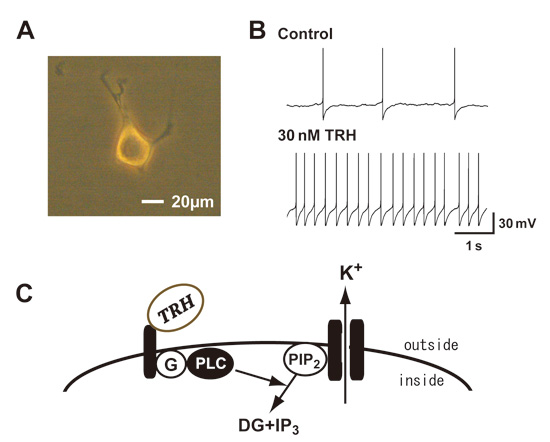Locus coeruleus (LC) noradrenergic neurons are implicated in a variety of functions including the regulation of vigilance and the modulation of sensory processing. Thyrotropin-releasing hormone (TRH) is an endogenous neuropeptide that induces a variety of behavioral changes including arousal and antinociception. In the present study, we explored whether the activity of LC noradrenergic neurons is modulated by TRH. Using current-clamp recording from isolated rat LC neurons, we found that TRH increased the firing rate of spontaneous action potentials. The TRH action was mimicked by TRH analogues including taltirelin and TRH-gly. In voltage-clamp recording at a holding potential of -50 mV, TRH produced an inward current associated with a decrease in the membrane K+ conductance. This current was inhibited by the TRH receptor antagonist chlordiazepoxide. Following inhibition of the pH-sensitive K+ conductance by extracellular acidification, the TRH response was fully inhibited. The TRH-induced current was also inhibited by the phospholipase C (PLC) inhibitor U-73122, but not by the protein kinase C inhibitor chelerythrine nor by chelation of intracellular Ca2+ by BAPTA. The recovery from the facilitatory action of TRH on the spike frequency was markedly inhibited by high concentration of wortmannin. These results suggest that TRH activates LC noradrenergic neurons by decreasing an acid-sensitive K+ conductance via PLC-mediated hydrolysis of phosphatidylinositol 4,5-bisphosphate. The present findings demonstrate that TRH activates LC neurons and characterize the underlying signaling mechanisms. The action of TRH on LC neurons may influence a variety of CNS functions related to the noradrenergic system which include arousal and analgesia.
Ishibashi H, Nakahata Y, Eto K, Nabekura J.
Excitation of locus coeruleus noradrenergic neurons by thyrotropin-releasing hormone.
J Physiol. 2009 Dec 1;587(Pt 23):5709-22.

(A) The phase contrast image of the acutely isolated locus coeruleus noradrenergic neuron.
(B) TRH increases spontaneous action potential frequency.
(C) Schematic representation of the TRH signaling pathway to depolarize membrane potential. TRH decreases resting K+ conductance via PLC-mediated hydrolysis of PIP2.